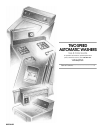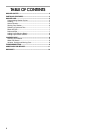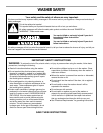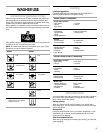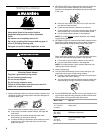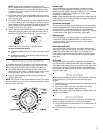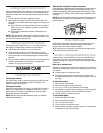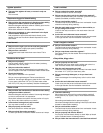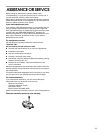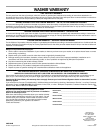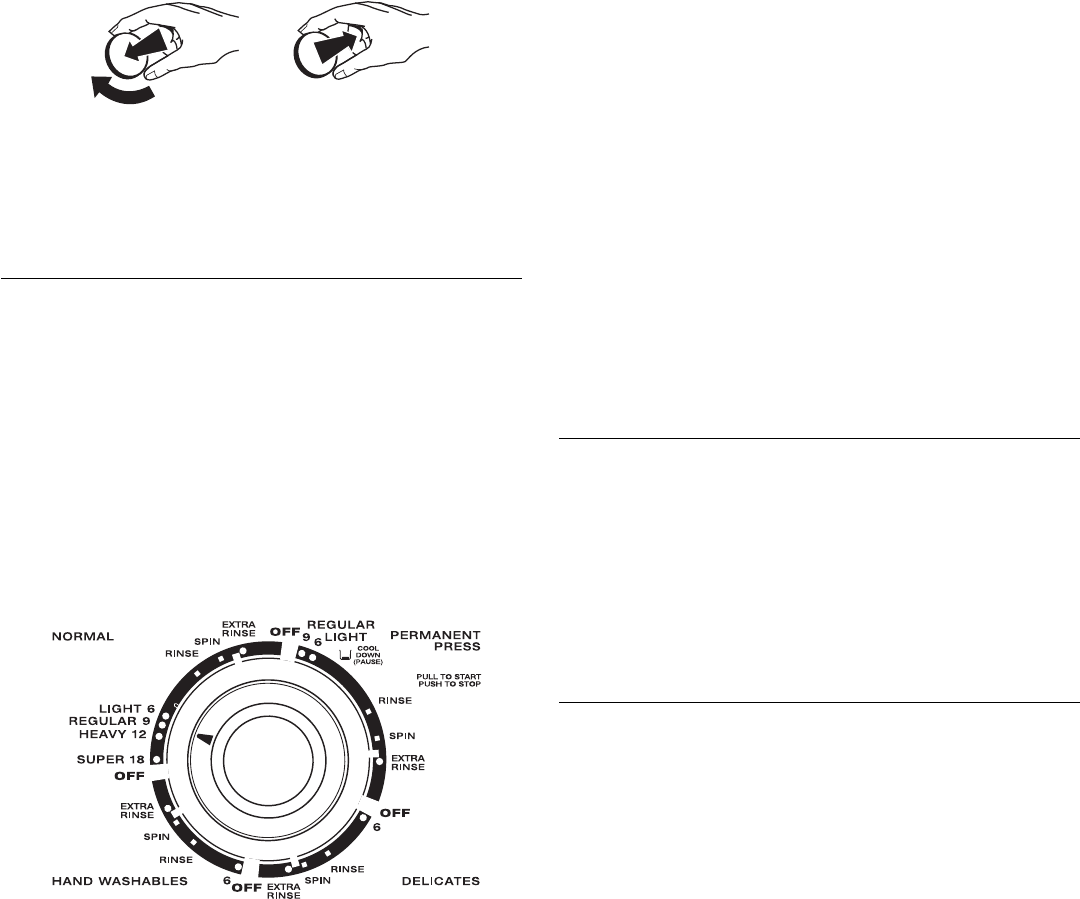
7
NOTE: In wash water temperatures colder than 70ºF
(21ºC), detergents do not dissolve well. Soils can be difficult
to remove. Some fabrics can retain wear wrinkles and have
increased pilling (the formation of small lint-like balls on the
surface of garments).
7. (OPTIONAL STEP) Set the EXTRA RINSE selector (on some
models) to ON if you want an additional rinse and spin at the
end of a wash cycle.
8. (OPTIONAL STEP) Set the END OF CYCLE SIGNAL selector
(on some models) to ON if you want your washer to alert you
when the wash cycle is complete. The signal is helpful when
you are washing items that should be removed from the
washer as soon as the cycle ends.
9. Push in the Cycle Control knob and turn it clockwise to the
wash cycle you want. Reduce the wash time when using a
small load size setting. See “Selecting a Cycle and Time.”
Pull out the Cycle Control knob to start the washer.
To stop or restart your washer
■ To stop the washer at any time, push in the Cycle Control
knob.
■ To restart the washer, close the lid (if open) and pull out
the Cycle Control knob.
Selecting a Cycle and Time
This section describes the available wash cycles and will help
you make the best cycle selections for your wash loads. Each
cycle is designed for different types of fabric and soil levels.
■ The washer pauses briefly throughout each cycle. These
pauses are normal. Refer to “Normal Sounds” to learn more
about the sounds you may hear during a wash cycle.
■ Refer to “Understanding Cycles” to learn what happens
during a wash cycle.
NOTE: This manual covers several different models. The washer
you purchased may vary from the model shown and will not have
all of the cycles described.
Cycle Control knob
Normal cycle
This cycle features high-speed agitation followed by a brief
period of low-speed agitation for cleaning cottons and linens.
High spin speeds shorten drying time. Select 6, 9, or 12 minutes
of wash time, depending on whether your load is lightly,
moderately or heavily soiled.
Super - Select the Super setting to wash heavily soiled loads that
need maximum soil removal. Use twice the amount of detergent
recommended for a wash cycle.
Permanent Press cycle
This cycle starts with high-speed agitation and then steps down
to low-speed agitation for cleaning permanent press blends and
synthetic fabrics. To minimize wrinkling, this cycle features a
cool-down rinse and a low-speed final spin. Select 6 or 9 minutes
of wash time to clean lightly to moderately soiled loads.
Delicates cycle
This cycle features a low-speed agitation for gentle soil removal
from delicate items and washable knits. Low spin speeds
minimize wrinkling. Use this 6-minute cycle to clean lightly to
moderately soiled loads.
Hand Washables cycle
This cycle features a series of brief, low-speed agitations and
short soaks to gently clean special-care items. Low spin speeds
minimize wrinkling. Wash small loads. If items appear to be
floating (due to trapped air), stop the washer by pushing in the
Cycle Control knob. Push items down into the washer. Restart
the washer.
Soak cycle
This cycle features brief periods of agitation and soak time to
help remove heavy soils and stains that need pretreatment. Use
warm water when soaking laundry. Hot water can set stains. Use
the amount of detergent or presoak additive recommended by
the manufacturer. After the Soak cycle ends, add detergent and
set a new wash cycle.
Rinse and Spin
When using extra detergent for heavily soiled clothes, or washing
special-care items, you may find an extra rinse and spin is
needed.
1. Push in the Cycle Control knob and turn it clockwise to any of
the Rinse settings.
2. Pull out the Cycle Control knob. The washer fills to the
selected load size, agitates, drains, and spins.
NOTE: An Extra Rinse option is available (on some models). See
“Starting Your Washer.”
Drain and Spin
A drain and spin may help shorten drying times for some heavy
fabrics or special-care items by removing excess water.
1. Push in the Cycle Control knob and turn it clockwise to any of
the Spin settings.
2. Pull out the Cycle Control knob. The washer drains, then
spins.



